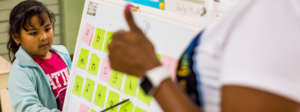Tests aren’t really the problem; the culture of testing is.
That’s the conclusion I come to after reading Teach Plus’s new study of time on testing, a welcome entry into a normally emotion- and anecdote-fueled debate. Despite some initial data challenges Teach Plus has since addressed, the report provides a detailed look at the culture of testing in a dozen districts across the country.
The headline is that the average amount of time students spend on state and district testing in a dozen urban districts is 1.7 percent of the school year. That sounds very modest, and seems to belie the conventional wisdom that schools are bubble-testing kids to death.
Teach Plus notes, however, that the difference in time-on-testing between “high testing” and “low testing” districts is significant, with district-mandated tests adding to state-required testing loads. Teachers surveyed as part of the study also estimate a higher amount of time spent on test administration, sometimes double or triple the amount calculated by Teach Plus based on district calendars.
As the report aptly notes, “There is no uniformity in ‘testing in America,’ rather a wide-ranging set of expectations that vary by district.” So what are we really talking about when we talk about “testing”?
The answer, I think, is not so much the tests themselves as the culture of testing that surrounds them, from test prep activities to results tracking and reporting. It’s drills and practice tests and communication about testing with students and parents. It’s all the stuff that can grow the true time-on-testing figure from a modest one or two percent to something that is considerably larger and may not be measurable by hours alone. It’s how a school reacts to testing—and too often, that reaction is feverish.
If the reaction is the real issue, then we ought to be thinking about different solutions than simply cutting tests. The fact that many schools have reacted irresponsibly to test-based accountability is not a strong argument for returning to an era of zero accountability.
To be sure, districts should assess their overall testing load and ensure it is reasonable. But even substantial reductions may not address the larger issues. A single test that is perceived to have extremely high stakes might translate to more test prep and time spent on testing than multiple lower-stakes tests. It’s also possible that better, more meaningful tests may actually increase time-on-testing (for example, due to the addition of new, open-ended questions that take more time to complete).
But the true challenge is avoiding a test-centric culture. And while changing culture is never simple or quick, the fact remains: School and district leaders control their destiny through the choices they make. Schools that focus on rigorous instruction, use assessment information thoughtfully and make reasoned decisions based on the data are not going to feel like test prep factories. Schools that forego critical subjects and skills in favor of a narrow, endless road to state math and ELA tests will be awful places for both teachers and students. But there is choice here. There is free will. The mere fact that students will be tested and schools held accountable is no excuse for running a bad school.
In the end, the best antidote for test obsession is a coherent instructional program and good teaching. Teachers, principals and district leaders can also take smaller steps to control the reaction to testing in their schools, like setting reasonable limits on test prep (making sure kids understand new test formats and basic test taking strategies is one thing; day after day of practice tests is another), giving teachers greater flexibility in when to administer tests, and reducing the impact of testing on other students (for instance, by creating separate computer labs for testing, so that they are not off-limits during testing times).
Teachers and principals, we’d love to hear what you think. What practical steps would make your school less test-centric? What’s feasible and what’s not? Email us and we’ll publish your ideas and suggestions.








